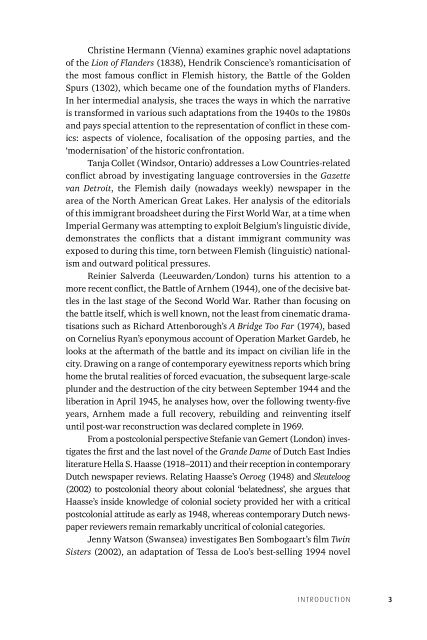Discord Consensus
7aze300jFJo
7aze300jFJo
Create successful ePaper yourself
Turn your PDF publications into a flip-book with our unique Google optimized e-Paper software.
Christine Hermann (Vienna) examines graphic novel adaptations<br />
of the Lion of Flanders (1838), Hendrik Conscience’s romanticisation of<br />
the most famous conflict in Flemish history, the Battle of the Golden<br />
Spurs (1302), which became one of the foundation myths of Flanders.<br />
In her intermedial analysis, she traces the ways in which the narrative<br />
is transformed in various such adaptations from the 1940s to the 1980s<br />
and pays special attention to the representation of conflict in these comics:<br />
aspects of violence, focalisation of the opposing parties, and the<br />
‘modernisation’ of the historic confrontation.<br />
Tanja Collet (Windsor, Ontario) addresses a Low Countries-related<br />
conflict abroad by investigating language controversies in the Gazette<br />
van Detroit, the Flemish daily (nowadays weekly) newspaper in the<br />
area of the North American Great Lakes. Her analysis of the editorials<br />
of this immigrant broadsheet during the First World War, at a time when<br />
Imperial Germany was attempting to exploit Belgium’s linguistic divide,<br />
demonstrates the conflicts that a distant immigrant community was<br />
exposed to during this time, torn between Flemish (linguistic) nationalism<br />
and outward political pressures.<br />
Reinier Salverda (Leeuwarden/London) turns his attention to a<br />
more recent conflict, the Battle of Arnhem (1944), one of the decisive battles<br />
in the last stage of the Second World War. Rather than focusing on<br />
the battle itself, which is well known, not the least from cinematic dramatisations<br />
such as Richard Attenborough’s A Bridge Too Far (1974), based<br />
on Cornelius Ryan’s eponymous account of Operation Market Gardeb, he<br />
looks at the aftermath of the battle and its impact on civilian life in the<br />
city. Drawing on a range of contemporary eyewitness reports which bring<br />
home the brutal realities of forced evacuation, the subsequent large-scale<br />
plunder and the destruction of the city between September 1944 and the<br />
liberation in April 1945, he analyses how, over the following twenty-five<br />
years, Arnhem made a full recovery, rebuilding and reinventing itself<br />
until post-war reconstruction was declared complete in 1969.<br />
From a postcolonial perspective Stefanie van Gemert (London) investigates<br />
the first and the last novel of the Grande Dame of Dutch East Indies<br />
literature Hella S. Haasse (1918–2011) and their reception in contemporary<br />
Dutch newspaper reviews. Relating Haasse’s Oeroeg (1948) and Sleuteloog<br />
(2002) to postcolonial theory about colonial ‘belatedness’, she argues that<br />
Haasse’s inside knowledge of colonial society provided her with a critical<br />
postcolonial attitude as early as 1948, whereas contemporary Dutch newspaper<br />
reviewers remain remarkably uncritical of colonial categories.<br />
Jenny Watson (Swansea) investigates Ben Sombogaart’s film Twin<br />
Sisters (2002), an adaptation of Tessa de Loo’s best-selling 1994 novel<br />
Introduction 3


